In the world of school-based behavior interventions, few strategies are as simple, scalable, and effective as Check-In Check-Out (CICO). Backed by research and widely used across K–12 schools, CICO helps students develop positive habits, improve self-awareness, and feel supported—without requiring intensive staffing or specialized programs.
As a Tier 2 behavior support within a PBIS (Positive Behavioral Interventions and Supports) framework, CICO provides structured daily feedback, adult mentorship, and opportunities for reflection and celebration. This post outlines what CICO is, why it works, and how to implement it successfully in your school—with a free downloadable CICO Daily Pointsheet template to get started.
Download our free CICO Daily Pointsheet template
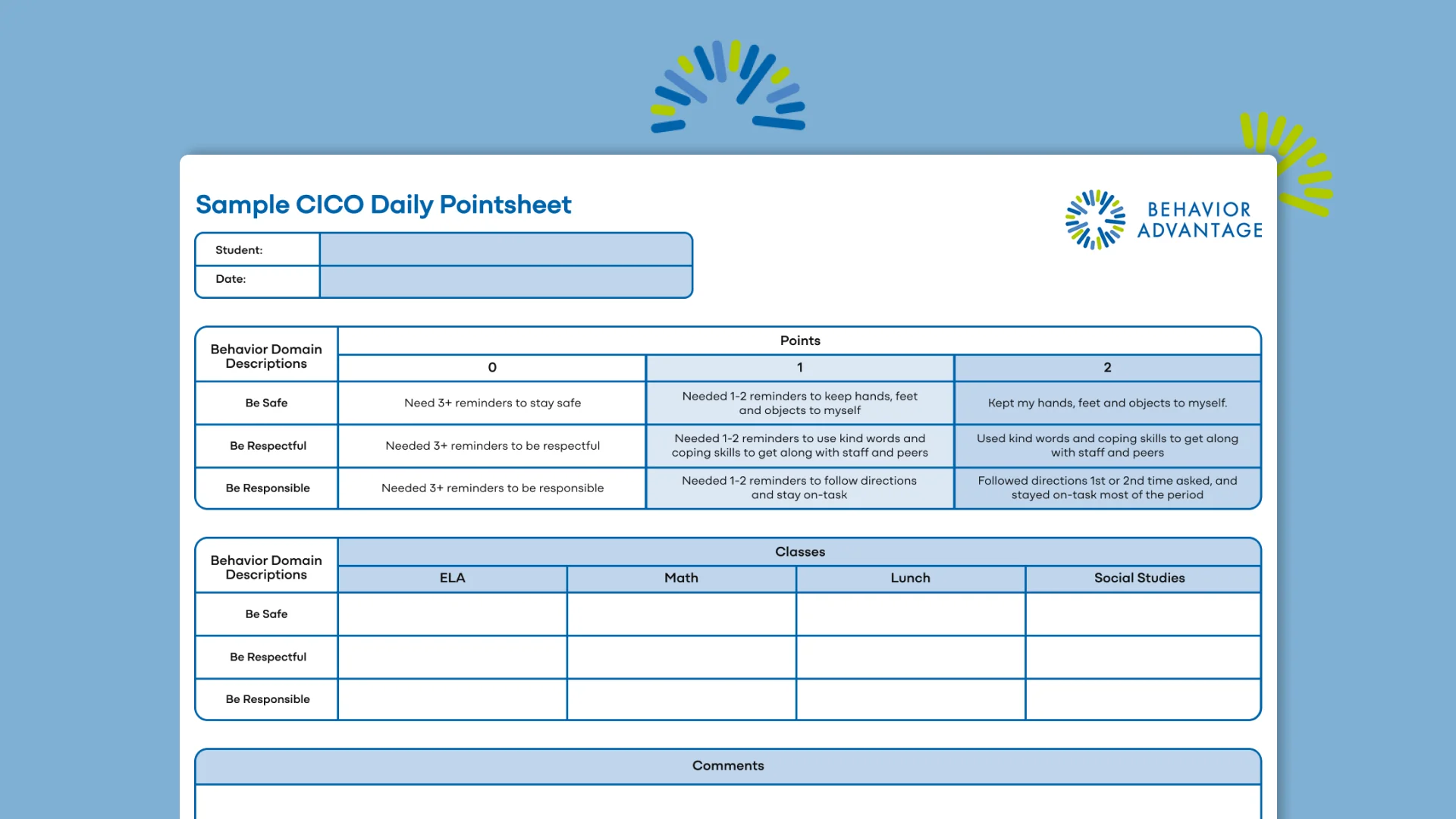
What Is CICO?
CICO is a targeted intervention designed for students who exhibit persistent, low-level disruptive behaviors or are not responding to Tier 1 supports alone. It provides a consistent routine of:
- Morning check-ins with a trusted adult (mentor or coach)
- Frequent feedback from teachers using a Daily Pointsheet
- Afternoon check-outs to review progress and reinforce goals
- Home communication to connect families to student success
This process reinforces school-wide expectations, encourages accountability, and builds positive staff-student relationships.
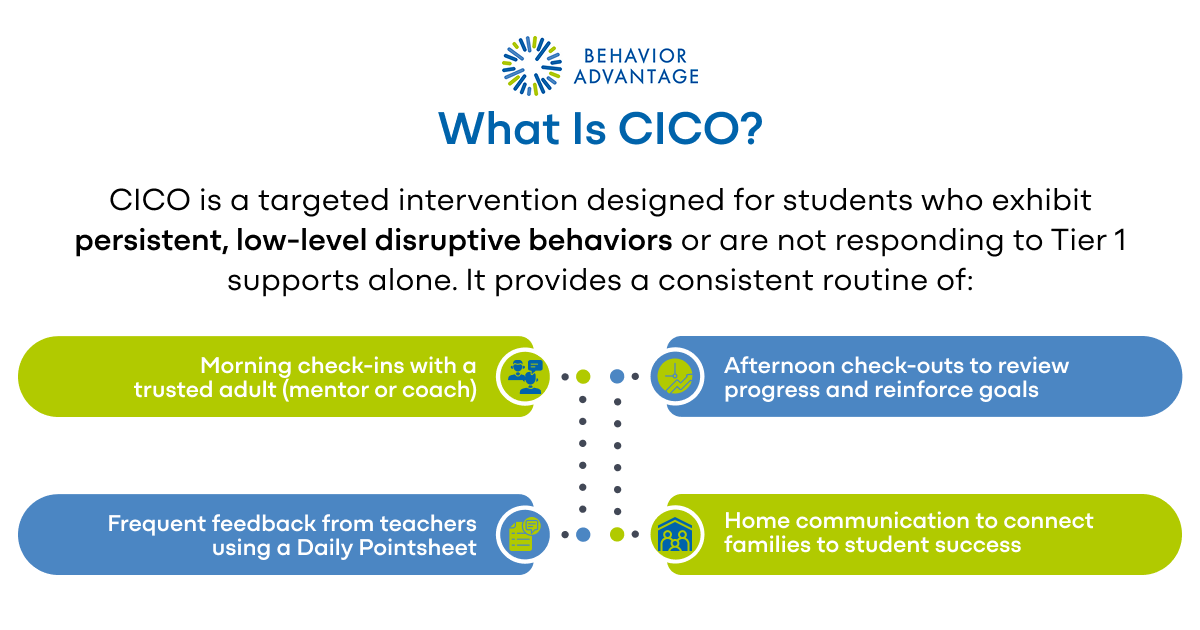
Why CICO Works: The Evidence
Research underscores the efficacy of CICO in improving student behavior. Studies have demonstrated that CICO can lead to:
- Reduction in Office Discipline Referrals (ODRs): Students participating in CICO often show a decrease in behavioral incidents requiring administrative intervention.
- Improved Academic Engagement: By addressing behavioral issues, students can focus more effectively on academic tasks.
- Enhanced Social Interactions: Regular feedback and adult mentorship contribute to better peer relationships and social skills.
One study in the Journal of Positive Behavior Interventions found that CICO led to significant behavior improvements in elementary students.
CICO is especially effective for students whose behaviors are maintained by adult attention. It may be less appropriate for students with histories of trauma, severe or persistent behavior patterns, or escape- or avoidance-maintained behavior, who may require more individualized and skill-based Tier 3 supports.
If you are interested in learning more about the different Tiers of support, be sure to check our comprehensive guide explaining the MTSS Pyramid.
Let’s walk through the daily components of CICO to better understand how it works and why it’s effective.
Morning Check-In: Building Positive Momentum
Each day begins with a short check-in between the student and their mentor. This is not a disciplinary conversation—it’s a supportive, goal-setting interaction.
In 3–5 minutes, they:
- Review behavioral goals on the Daily Pointsheet
- Set a target score or outcome for the day
- Discuss any anticipated challenges or reminders for success
Mentors don’t need to be behavior specialists—any consistent, caring adult (office staff, teacher, paraprofessional) can fill the role. The key is positivity, predictability, and encouragement.
Midday Feedback: Structured, Supportive, and Specific
As the student progresses through the day, teachers provide brief feedback on how well they are meeting expectations. Each class period is scored on the Daily Pointsheet using a simple rating system (e.g., 0–2 scale).
Feedback should be:
- Brief – no need for lengthy conversations
- Specific – tied to defined expectations
- Constructive – framed around growth and reinforcement
Example:
“Great job raising your hand and staying on task—that’s a 2 for Responsibility!”
“You needed multiple reminders to follow directions—let’s mark a 1 for Respect.”
Over time, students learn patterns in their behavior and how their choices impact their day. Teachers should calibrate regularly to ensure consistency in scoring.
Self-Monitoring: Empowering Students
Adding self-monitoring whenever possible can boost student engagement and accountability. Before giving a score, teachers or mentors might ask:
- “How do you think you did?”
- “What would you rate yourself for Safety this period?”
Students may initially rate themselves inaccurately, but with coaching, they become more honest and reflective. You can even reward accurate self-assessment to build this skill.
This empowers students to internalize expectations and take ownership of their behavior.
Afternoon Check-Out: Reinforcing Growth
At the end of the day, the student checks out with their mentor to:
- Review their scores and compare them to their daily goal
- Celebrate successes and reflect on any challenges
- Receive reinforcement if they met their target
- Prepare to share progress with family (if applicable)
Reinforcers don’t need to be elaborate. Many students respond to:
- Praise and high-fives
- Tokens toward a reward or privilege
- Extra choice time or a preferred activity
- Positive notes or texts sent home
This closing interaction reinforces the idea that effort and progress are noticed and valued.
Home Communication: Connecting Families
The Daily Pointsheet is typically sent home for a parent or guardian to review and sign. This simple step promotes school-home collaboration and helps families celebrate their child’s growth.
In some cases, schools may choose to:
- Send reports digitally through email or a platform like Behavior Advantage
- Use messaging apps or automated updates
- Translate Daily Pointsheets and teacher comments for multilingual families
Not every caregiver will engage daily, and that’s okay. The goal is to open the door to communication, not create a burden.
The Role of the CICO Team
Successful CICO implementation is supported by a small team who:
- Monitors student progress
- Reviews data biweekly or monthly
- Makes adjustments when needed
This team may be the same members—or a subgroup—of your school’s MTSS (Multi-Tiered System of Supports) team, depending on your staffing structure and meeting frequency. Integrating CICO review into your broader MTSS process ensures that student support decisions are aligned across academic, behavioral, and social-emotional domains. A sample team might include:
- The student’s mentor
- A classroom teacher
- A behavior specialist or counselor
- A school administrator
Read our comprehensive guide on how to build an effective MTSS Team for additional recommendations.
Using a spreadsheet or digital platform like Behavior Advantage, the CICO team meets regularly to review progress and trends to make data-based decisions about continuing or adjusting the approach. For example:
Lucas, a third grader, improves in Respect and Safety but struggles with Responsibility. The team adds a checklist to support task completion.
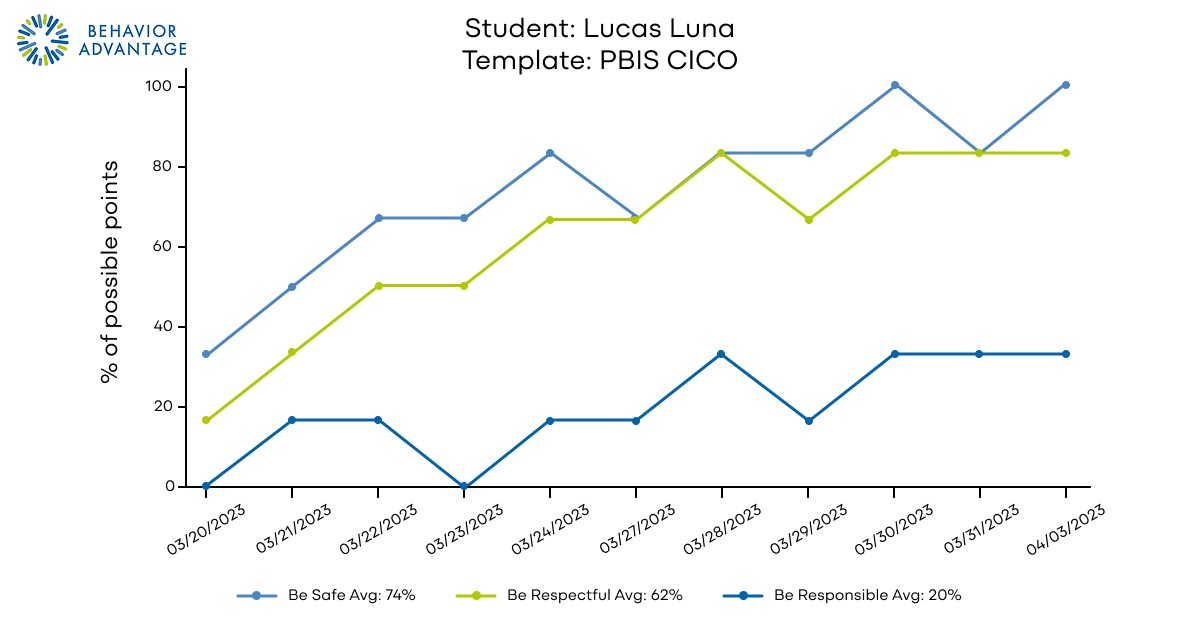
Ally, an eighth grader, earns low scores in fourth period. The team meets with the teacher to explore classroom dynamics and adjust supports.
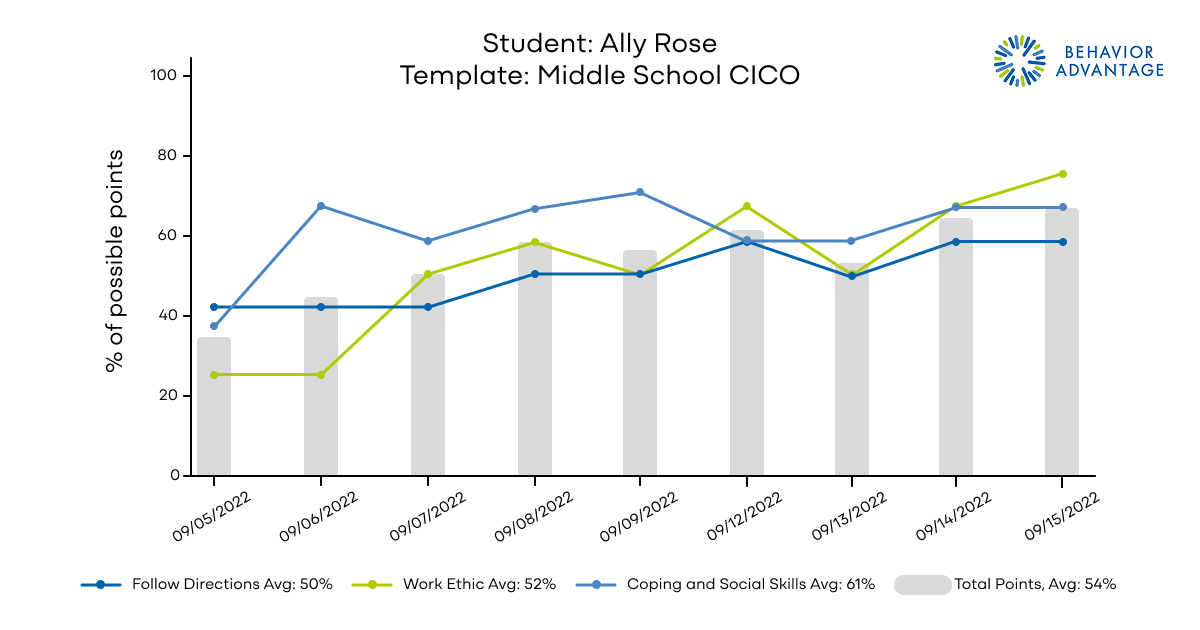
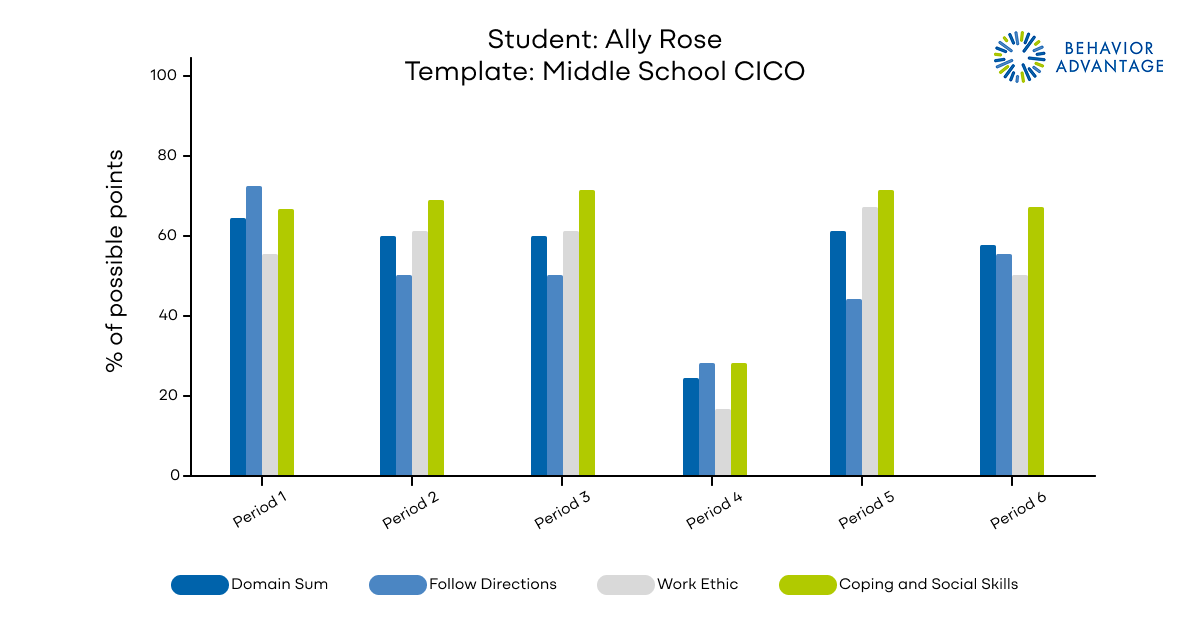
These discussions, anchored in data, keep CICO responsive, student-centered, and solution-focused.
Common Challenges (and How to Solve Them)
- Scoring Inconsistency (Scoring Drift)
Solution: Provide regular calibration training and ensure staff use objective definitions for each score. - Student Burnout or Lack of Motivation
Solution: Revisit goals to ensure they’re achievable. Refresh reinforcers and give the student a voice in what they’re working toward. - Negative or Punitive Feedback
Solution: Model and coach adults to give respectful, strength-based feedback. CICO should never be used to shame or criticize. - Caregiver Non-Engagement
Solution: Offer flexible communication options (e.g., email, messaging apps) and shift the focus from “compliance” to celebrating progress.
Conclusion: Scalable, Supportive, and Student-Centered
One of the greatest strengths of Check-In Check-Out is its flexibility and scalability. Whether you’re in a large urban district or a small rural school, CICO can be adapted to meet your setting, resources, and student needs. Schools have successfully implemented CICO using:
- Paper-based Daily Point Sheets stored in student folders or binders
- Digital tools like Behavior Advantage to track progress and share data
- Shared scoring rubrics and clear expectations to maintain consistency across staff
As long as the core components remain—positive check-ins, consistent feedback, opportunities for reflection, and regular team review—your school can tailor the approach to fit your systems.
But more than logistics, CICO is about building connection and growth. Done well, it helps students:
- Build confidence and accountability
- Strengthen relationships with supportive adults
- Learn to reflect, reset, and improve
- Experience daily wins that lead to long-term success
Whether you’re just getting started or refining your current CICO system, the key is to stay consistent, be responsive, and keep students at the center of the work. With a committed team and a thoughtful approach, CICO can be a powerful tool for meaningful, positive change.
At Behavior Advantage, we can help you achieve that.









